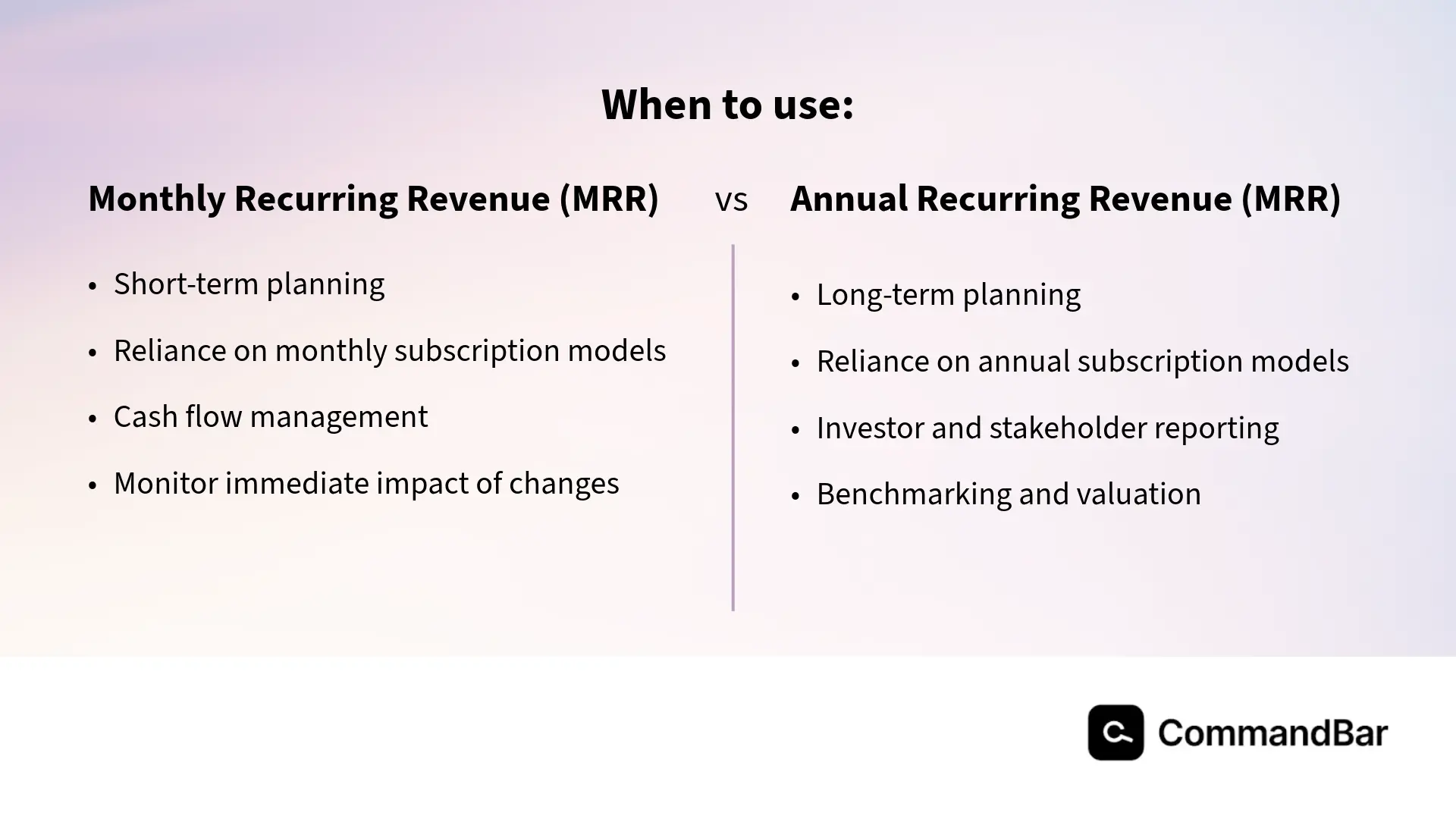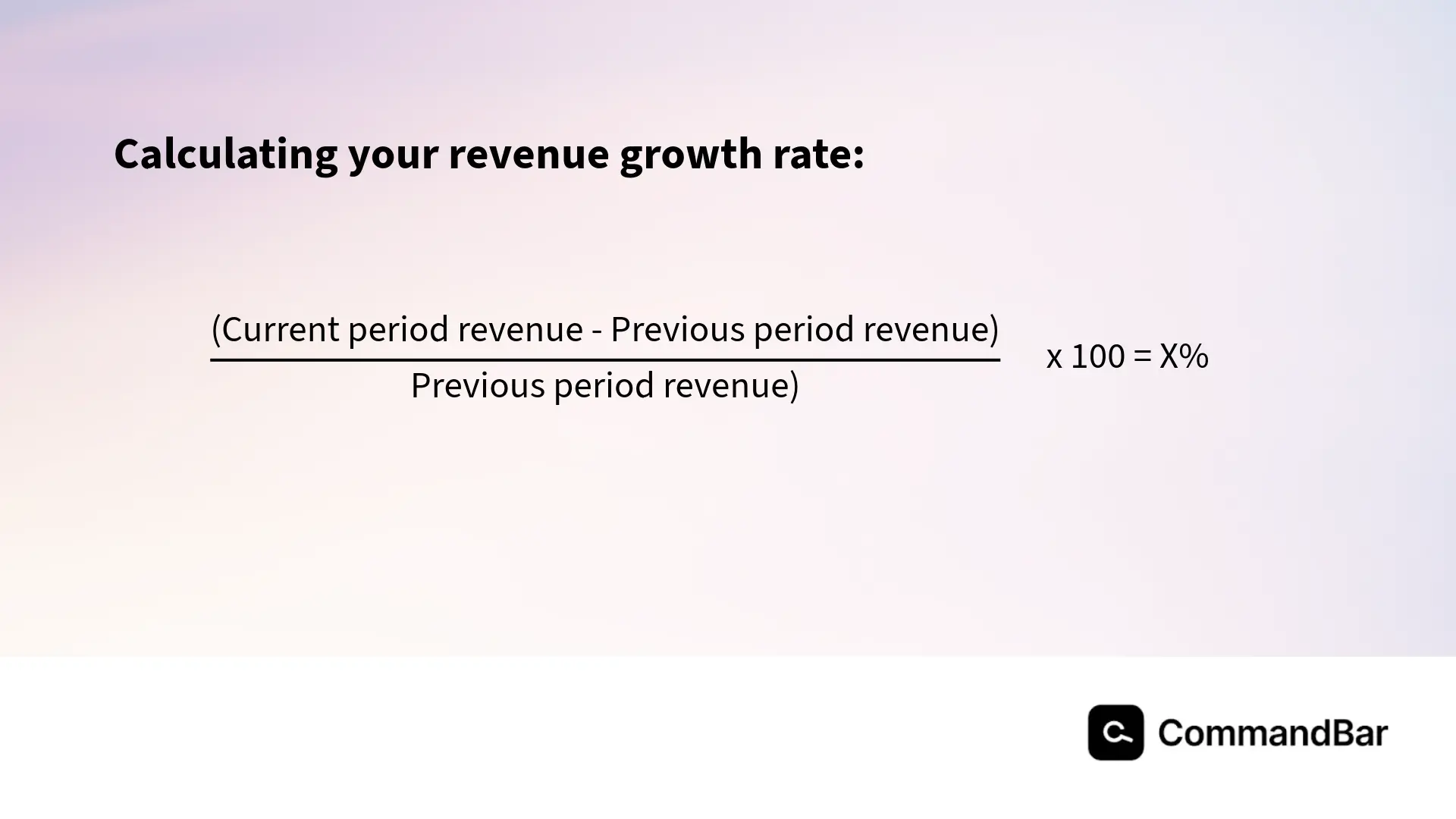Demystifying revenue growth rate for SaaS companies
As a SaaS company, we don’t have to highlight how important revenue growth is. But knowing what to do with it… that’s another story.

Revenue growth rate is often considered the golden child of SaaS metrics and KPIs. In many ways, the success of your company rests mostly on the success of this metric. But at the same time, it can feel extremely intangible. Especially for product managers, attempting to move this metric forward can feel like throwing spaghetti at the wall and hoping it sticks.
So given its importance, how can you be strategic about aligning your objectives to make a real impact on revenue?
But before we get into all of the strategic nitty gritty, let’s first talk a little more about what’s going on behind the curtain of this magical metric.
What is a revenue growth rate?
Your revenue growth rate, simply put, is the comparison of your revenue in one period to your revenue in another, expressed as a percentage. This includes your revenue from subscriptions, services, and any other recurring revenue streams.
Typically, companies will calculate their revenue growth rate on a monthly, quarterly, or annual basis.
This metric is especially important in SaaS
For SaaS companies especially, your revenue growth rate is more than just a number. It’s a comprehensive measure of your company’s success, sustainability, and future potential.
Your growth rate will demonstrate how quickly you’re expanding your sales, but also your ability to retain existing customers and upsell or cross-sell.
You’ll leverage this metric not only for investors that you’re trying to lure in or maintain relationships with, but also for your internal management teams to leverage for strategic decision-making.
Because of SaaS’s reliance on recurring models, revenue growth rate is especially important to track because it:
- Measures business health - This metric is a reflection of your ability to get and keep new customers. In a recurring revenue model, low churn rates and high customer satisfaction are crucial.
- Supports strategic decison-making - Your revenue growth rate helps you to accurately forecast future performance, budget, and effectively allocate resources. You can adjust your strategies based on whether you’re meeting, exceeding, or falling short of your growth targets.
- Attracts investors - Although there was a boom in SaaS investing several years ago, getting funding is not quite as easy in 2024. Being able to hold up a strong revenue growth rate to investors can ease some of their worries about risk and take the leap with you.
How to calculate your revenue growth rate
It seems like a simple metric on the surface, but it requires a little more strategy to make sure you’re working with the most accurate, most relevant numbers.
So, I’ll walk you through it step-by-step.
1. Determine the periods for comparison
As I mentioned earlier, SaaS companies can either calculate this on a month-over-month, year-over-year, or quarter-over-quarter basis, depending on how granular they need to get.
What time period you choose will differ from one context to the next. Both your business model and your goals in calculating this (i.e. what you’re going to be using this metric for) will determine which periods best support your strategy.

When to measure MRR growth (Monthly Recurring Revenue):
- For short-term planning
- When you rely on monthly subscription plans primarily
- For more effective cash flow management
- To monitor the immediate impact of changes, like marketing campaigns, product updates, pricing changes, etc.
When to measure ARR growth (Annual Recurring Revenue)
- For long-term planning with a broader view
- When you rely on annual subscription plans primarily
- For investor and stakeholder reporting
- For benchmarking and valuation purposes
2. Grab your revenue stats
Collect data about your total revenue for both periods (i.e. this month and last month), making sure you consider all revenue streams.
Data accuracy is one of the most important boxes to check here, so take a little extra time to make sure that the data you’re using is reliable and up-to-date.
3. Use the revenue growth rate formula
The formula itself is pretty simple. You just subtract your previous period’s revenue from your current period’s revenue and then divide that number by the previous period’s revenue. Finally, you multiply it by 100.

This will give you the growth rate as a percentage, which will indicate either an increase or a decrease.
For example, let’s say you want to calculate your revenue growth rate from last year to this year. If your revenue last year was 1.5 million and this year your revenue was 2.2 million, the calculation would go as follows:
(2,200,000-1,500,000)/1,500,000 = 0.47 * 100, which gives you a 47% annual revenue growth rate.
Analyzing Revenue Growth Rate
So what is considered a “good” growth rate? Although this can vary a ton, depending on the age of the company, the current market, and industry, there are some general benchmarks you can use.
The top quartile of SaaS companies have an average growth rate of 60-70%, and median SaaS companies typically hover around 30% annually.
Reporting tends to be one of the biggest challenges for SaaS companies. And while reliable data is important to give you a strong foundation for your metrics, what you do with those metrics you pull is ultimately where the impact happens.
Different growth rates can signal various states of business performance, potential challenges, and opportunities. So let’s look at what your revenue growth rate can tell you about your business.
If you have a high growth rate:
You’re in a phase of rapid expansion, acquiring new customers at a fast pace and increasingly growing your market share. This is extremely common in early-stage companies targeting untapped markets.
Your marketing and sales strategies are effective, and this is an indicator to stay the course for now and perhaps consider even upping your investment in the strategies that are working.
However, it may also be an indicator that you need to consider possible scaling issues on the horizon. You should start planning upcoming infrastructure investments, hiring more staff, and strategies to maintain quality as you grow.
If you have a moderate growth rate:
If this growth is consistent, it’s a great sign that you have a mature and sustainable business model. You’ve established a really solid market presence and a loyal customer base.
It also indicates that you have balanced operations that successfully juggle customer acquisition, retention, and operational efficiency. You’re likely optimizing your operations and focusing on profitability.
Of course, one potential downside of this moderate metric is that you may be approaching market saturation, signaling that you should consider exploring new markets or innovating your offerings to spur a new period of growth.
If you have low (or negative) growth rates:
This could signal a range of challenges, including an increase in competition, market saturation, or a lack of product-market fit, among others. This means it’s time to reassess your marketing strategy, your product offerings, or even your customer service processes.
It may also mean that your customer acquisition isn’t in balance with your churn. Even if you’re great at getting tons of new customers every month, it may be undercut by poor quality, unsustainable pricing, or ineffective customer support.
Overall, a low or negative revenue growth rate is telling you that the need to review and strategize is urgent, especially if negative growth is persistent. Perhaps it’s time to bring in a strategic consultant, get out there and talk to your ideal customers to uncover real pain points, or make investments in areas that you’ve been neglecting.
If your metrics are all over the place:
If you have a really volatile revenue growth rate that is way up some months and way down others, your company may be extra sensitive to market changes, seasonal trends, or other external factors outside of your control.
While this can be normal in the early stages of a company, you’ll want to analyze it closely to understand the underlying causes and nail down some strategies to be proactive about getting ahead of the ups and downs.
In other cases, this may simply be a side effect of your product lifecycle. If you notice large spikes during periods of new releases and dips as the product matures, this is pretty normal.
Whether you have what you consider to be high, medium, or low growth, the importance of benchmarking cannot be overstated here. What’s considered a high growth rate in one industry may be considered low in another. To accurately leverage your revenue growth rate to make strategic decisions, you’ll need to look at it in context.
You also have to consider the lifecycle phase that your company is in. High growth is expected in the early stages, but more mature companies typically aim for steadier, more sustainable growth.
What factors may be influencing your revenue growth rate (and how to use them to enhance it)
Let’s dig a little deeper into some of the possible factors that are influencing your revenue growth rate, whether positively or negatively, and how you can take advantage of some strategies to continue to grow.
Customer acquisition
Your ability to bring on new customers is one critical piece of the puzzle in strong and sustainable revenue growth. If your revenue growth rate isn’t quite where you need it to be, and you can trace it to low numbers of new customers, it may be time to enact some new strategies in both sales and marketing.
Or it may be time to invest in some product innovation to help you overcome any current barriers you’re experiencing.
Customer retention and churn rate
Despite how important it is to get new customers, your existing customers are arguably a more critical investment. It’s more cost-effective and helps you build some (lucrative) long-term relationships.
Investors are flocking to steady revenue like moths to a flame right now.
Providing a positive and engaging user experience can help you boost low revenue growth or keep high revenue growth trending upward. Some areas you may want to invest in are smooth onboarding that creates power users, providing genuinely helpful support, and communication with users.
Expansion revenue
In a similar vein to retaining your customers, you also want to upsell and cross-sell to expand their lifetime value. If your growth rate isn’t where you want it to be but you have a great base of existing clients, consider building strategies around promoting additional features, products, or higher-tier subscriptions.
Pricing strategy
Sometimes, you may have the right product for the right market at the right time, but the wrong pricing is sabotaging you. Either your pricing is too high to the point that it’s turning valuable potential customers away, or it’s too low where you’re losing out on revenue that people are willing to pay (or even sacrificing your reputation as a high-value product).
In order to expand your revenue growth, you may want to consider analyzing your pricing strategy to make sure you’re balancing affordability for customers and sustainable revenue for your SaaS company.
Revenue growth rate is a beast, but it’s one you can tackle
No matter what your growth rate is, under its surface is a wealth of knowledge that you can leverage to help you grow.
As I hope I’ve made clear here, there are so many different factors that feed into the rate at which your revenue is growing. So use this metric as a starting to point and as an excuse to be curious. Don’t just calculate your growth rate to pass on to investors, take the time to understand what’s contributing to it and to strategically adjust to make sure your SaaS company can continue to grow.
